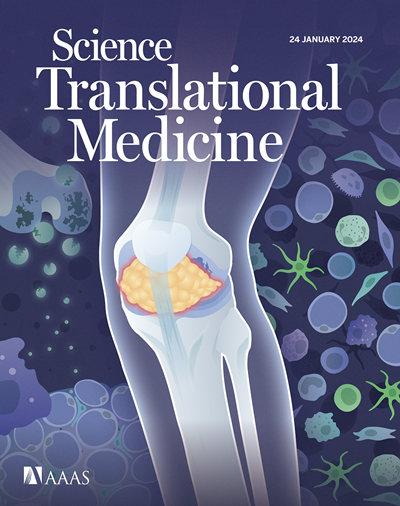葡萄糖转运体 GLUT10 支持 CD8+ T 细胞的活化和抗肿瘤免疫,而乳酸则会破坏 CD8+ T 细胞的活化和抗肿瘤免疫。
IF 15.8
1区 医学
Q1 CELL BIOLOGY
引用次数: 0
摘要
CD8+ T细胞活化会导致效应T细胞(Teffs)快速增殖和分化,从而介导抗肿瘤免疫。虽然有氧糖酵解在 CD8+ Teffs 中优先被激活,但在低糖和酸性肿瘤微环境(TME)中调控 CD8+ T 细胞葡萄糖摄取的机制仍然鲜为人知。在此,我们报告了葡萄糖转运体 GLUT10 在 CD8+ T 细胞活化和抗肿瘤免疫过程中的丰度增加。具体来说,GLUT10 缺乏会抑制葡萄糖摄取、糖酵解和肿瘤浸润 CD8+ T 细胞的抗肿瘤效率。仅补充葡萄糖不足以挽救TME中CD8+ T细胞的抗肿瘤功能和葡萄糖摄取。通过分析肿瘤环境代谢物,我们发现高浓度乳酸通过直接与 GLUT10 的胞内基团结合,降低了 CD8+ T 细胞的葡萄糖摄取、活化和抗肿瘤作用。通过模拟肽 PG10.3 破坏乳酸与 GLUT10 的相互作用,可促进 CD8+ T 细胞的葡萄糖利用、增殖和抗肿瘤功能。PG10.3 与 GLUT1 抑制剂或抗程序性细胞死亡 1 抗体的联合治疗显示出协同抗肿瘤作用。总之,我们的数据表明,CD8+ T 细胞的葡萄糖摄取选择性地需要 GLUT10,并确定 TME 积累的乳酸通过直接与 GLUT10 结合并降低其葡萄糖转运能力来抑制 CD8+ T 细胞的效应功能。最后,我们的研究表明,破坏乳酸与 GLUT10 的结合是一种很有前景的治疗策略,可增强 CD8+ T 细胞介导的抗肿瘤作用。本文章由计算机程序翻译,如有差异,请以英文原文为准。
Activation and antitumor immunity of CD8+ T cells are supported by the glucose transporter GLUT10 and disrupted by lactic acid
CD8+ T cell activation leads to the rapid proliferation and differentiation of effector T cells (Teffs), which mediate antitumor immunity. Although aerobic glycolysis is preferentially activated in CD8+ Teffs, the mechanisms that regulate CD8+ T cell glucose uptake in the low-glucose and acidic tumor microenvironment (TME) remain poorly understood. Here, we report that the abundance of the glucose transporter GLUT10 is increased during CD8+ T cell activation and antitumor immunity. Specifically, GLUT10 deficiency inhibited glucose uptake, glycolysis, and antitumor efficiency of tumor-infiltrating CD8+ T cells. Supplementation with glucose alone was insufficient to rescue the antitumor function and glucose uptake of CD8+ T cells in the TME. By analyzing tumor environmental metabolites, we found that high concentrations of lactic acid reduced the glucose uptake, activation, and antitumor effects of CD8+ T cells by directly binding to GLUT10’s intracellular motif. Disrupting the interaction of lactic acid and GLUT10 by the mimic peptide PG10.3 facilitated CD8+ T cell glucose utilization, proliferation, and antitumor functions. The combination of PG10.3 and GLUT1 inhibition or anti–programmed cell death 1 antibody treatment showed synergistic antitumor effects. Together, our data indicate that GLUT10 is selectively required for glucose uptake of CD8+ T cells and identify that TME accumulated lactic acid inhibits CD8+ T cell effector function by directly binding to GLUT10 and reducing its glucose transport capacity. Last, our study suggests disrupting lactate-GLUT10 binding as a promising therapeutic strategy to enhance CD8+ T cell–mediated antitumor effects.
求助全文
通过发布文献求助,成功后即可免费获取论文全文。
去求助
来源期刊

Science Translational Medicine
CELL BIOLOGY-MEDICINE, RESEARCH & EXPERIMENTAL
CiteScore
26.70
自引率
1.20%
发文量
309
审稿时长
1.7 months
期刊介绍:
Science Translational Medicine is an online journal that focuses on publishing research at the intersection of science, engineering, and medicine. The goal of the journal is to promote human health by providing a platform for researchers from various disciplines to communicate their latest advancements in biomedical, translational, and clinical research.
The journal aims to address the slow translation of scientific knowledge into effective treatments and health measures. It publishes articles that fill the knowledge gaps between preclinical research and medical applications, with a focus on accelerating the translation of knowledge into new ways of preventing, diagnosing, and treating human diseases.
The scope of Science Translational Medicine includes various areas such as cardiovascular disease, immunology/vaccines, metabolism/diabetes/obesity, neuroscience/neurology/psychiatry, cancer, infectious diseases, policy, behavior, bioengineering, chemical genomics/drug discovery, imaging, applied physical sciences, medical nanotechnology, drug delivery, biomarkers, gene therapy/regenerative medicine, toxicology and pharmacokinetics, data mining, cell culture, animal and human studies, medical informatics, and other interdisciplinary approaches to medicine.
The target audience of the journal includes researchers and management in academia, government, and the biotechnology and pharmaceutical industries. It is also relevant to physician scientists, regulators, policy makers, investors, business developers, and funding agencies.
 求助内容:
求助内容: 应助结果提醒方式:
应助结果提醒方式:


